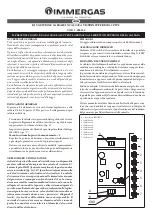
17
6
Condensate Disposal
6.1 General requirements
When in condensing mode the Grant
Vortex PRO boilers produce condensate
from the water vapour in the flue gases.
This condensate is slightly acidic with a
ph value of around 3 (similar to vinegar).
Provision must be made for the safe and
effective disposal of this condensate.
Condensate can be disposed of
using one of the following methods of
connection:
Internal Connection (preferred option):
• Into an internal domestic waste
system (from kitchen sink, washing
machine, etc.).
• Directly into the soil stack.
External Connection:
• Into an external soil stack
• Into an external drain or gully
• into a rainwater hopper (that is part
of a combined system where sewer
caries both rainwater and foul water)
• purpose made soakaway.
All condensate disposal pipes
must
be fitted with a trap - whether they are
connected internally or externally to
a domestic waste system/soil stack
or run externally to a gully, hopper or
soakaway.
6.2 Connections
Connections into a rainwater hopper,
external drain or gully should be
terminated inside the hopper / drain /
gully below the grid level but above the
water level.
Condensate disposal pipes should not
be connected directly into rainwater
downpipes or to waste / soil systems
connected to septic tanks.
Condensate should not be discharged
into ’grey water’ systems that re-use
water used in the home (not including
water from toilets).
It should be noted that connection of
a condensate pipe to the drain may
be subject to local Building Control
requirements.
6.3 Pipework
Condensate disposal pipework must be
plastic (plastic waste or overflow pipe is
suitable).
Copper or steel pipe is NOT suitable
and MUST NOT be used.
Condensate disposal pipes should
have a minimum ‘nominal’ diameter
of 22mm (
3
/
4
”) - e.g. use 21.5mm OD
polypropylene overflow pipe.
Condensate disposal pipes must be
fitted with a fall (away from the boiler) of
at least 2.5° (~45mm fall per metre run).
Where it is not possible for the
pipe to fall towards the point of
discharge - either internally into
a waste system or externally to a
gully (e.g. for boilers installed in a
basement), it will be necessary to
use a condensate pump.
Condensate disposal pipes should
be kept as short as possible and the
number of bends kept to a minimum.
Pipes should be adequately fixed to
prevent sagging, i.e. at no more than
0.5 metre intervals.
6.4 External Pipework
Ideally, external pipework, or pipework
in unheated areas, should be avoided. If
unavoidable, external pipework should
be kept as short as possible (less than
3 metres) and 32mm waste pipe used
to minimise the risk of ice blocking the
pipe in freezing conditions.
The number of bends, fittings and joints
on external pipes should be kept to a
minimum to reduce the risk of trapping
condensate.
For a boiler installed in an unheated
area such as an outhouse or garage,
all condensate pipework should be
considered as an ‘external’.
6.5. Condensate Soakaway
To keep external pipework to a
minimum, locate the soakaway as close
as possible to the boiler but ensure
it is at least 500mm from building
foundations and away from other
services, e.g. gas, electricity, etc.
The condensate pipe may be run above
or below ground level and can enter
either the top or side of the soakaway
tube. Refer to Fig.6-1.
Ensure that the drainage holes in the
soakaway tube face away from the
building. Backfill both the soakaway
tube, and the hole around it, with
10mm limestone chippings.
Only use a soakaway where the soil is
porous and drains easily. Do not use
in clay soils or where the soil is poorly
drained.
Any damage due to condensate
backing up into the boiler due to a
high water table, in the case of a
soakaway, or flooded drains when
the condensate disposal is via a
gully or soil stack, is not covered by
the Grant product guarantee.
!
nOtE
!
nOtE
!
nOtE
!
CaUtiOn
Figure 6-1:
Purpose made condensate soakaway
32mm waste pipe
external to the building
Two rows of 3 x 12mm
holes at 25mm centres and
50mm from the bottom
of the tube. Holes facing
away from the property.
Backfill with
10mm limestone
chippings
Sealed
end
100mm
plastic tube
Cement seal
Ground level
2.5° fall
25mm
300mm
400mm min.
















































